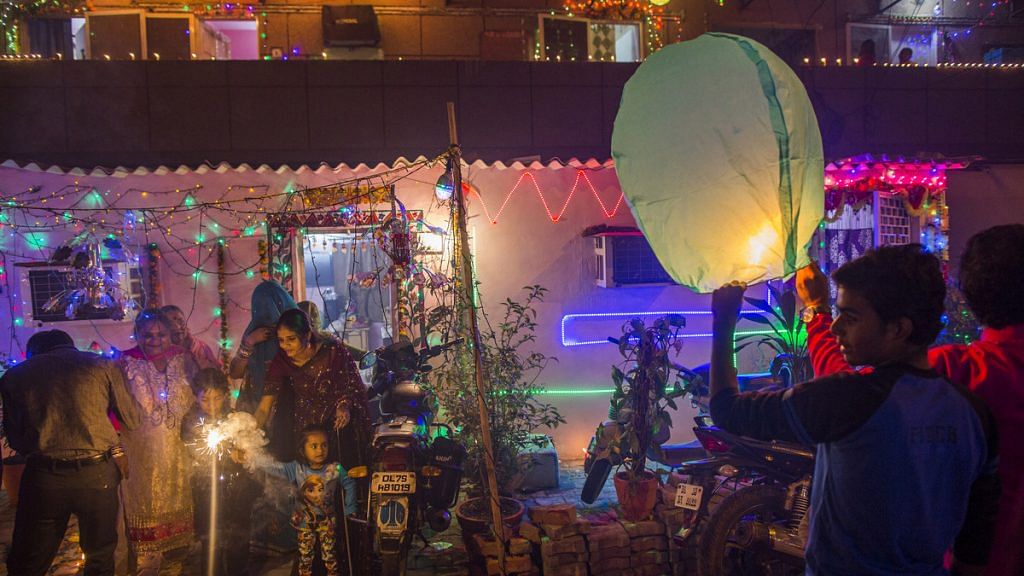The pollution this festive season shows the middle class is increasingly self-indulgent, with little regard for laws and rules.
This Diwali season showed yet again the vaingloriousness, bordering on cultural bankruptcy, of the Indian urban middle class.
It is perhaps a characteristic of the new, self-indulgent, consumerist middle class across the world but it is more pronounced in Indian cities.
Pollution and decibel levels were high this festive season, not only in Delhi but even in Mumbai that is offered a blanket of protection by the winds of the Arabian Sea.
Of late, however, decibel levels are almost always very high, whether it is the festival season or not.
Also read: Four years of Narendra Modi have not just failed India’s middle class but also the RSS
Marriage ceremonies of the various middle classes, for instance, are becoming noisier and noisier.
Once, this very upper-caste, upper-class used to look down upon those below them in the social hierarchy, with particular scorn for their ‘noisy and loud’ ceremonies.
Till the 70s and the 80s, the middle class used to shy away from extensive baraats of bridegrooms arriving on horses or cars or decorated chariots.
These days, the already clogged traffic gets a middle-class marriage addition, replete with women, men and children swaying to Bollywood music amid bursting crackers.
There is little regard for laws and rules, and even lesser civic sense to prevent the unruly and callous social behaviour. This utter lack of concern defines the middle-class lifestyle and culture of today.
One of the reasons for this phenomenon is the sharp rise in middle-class incomes, after mid-80s and particularly the liberalised 90s.
The number of double income, even triple income families, has visibly risen. It is estimated that about 40 per cent, or nearly 50 crores, or 500 million people, are in various layers of this class.
Also read: As BJP’s Hindutva grew, India’s pleasure-seeking middle classes looked away
Most of them are white collar workers. A huge number are central government, state government, semi-government as well as employees in public sector corporations, banks, railways and other government of India undertakings. In addition to this, the burgeoning private sector has also created substantial wealth.
With husband and wife, and sometimes son and daughter-in-law also working, family incomes are substantially higher than the average Indian households.
This explosion of affluence has made most of them indifferent to broader social and public issues.
If one travels to semi-urban areas, it is possible to see many families, which would have been in the lower middle-class category just two decades ago, flaunting cars and high-end fashion.
One need not envy or resent them. They have a right like all others to be aspirational and enjoy modern amenities.
There is, however, a big difference between the standard of living, quality of life and lifestyle.
While the standard of living has seen a sharp upgrade with rising incomes, the quality of life has declined.
The opulence in marriages, such as even inviting celebrities by paying them their “fees”, has found its way to other such family events.
Indeed, all such events from thread ceremonies, bhoomi pujas, to kuldaivat pujas have become big-ticket events. These celebrations are held in plush hotels and massive lawns with glittering decor.
Also read: Delhi’s air quality today is as bad as it was a day after Diwali in 2017
One has never seen such self-indulgent, hedonistic lifestyle in the middle class.
The renowned sociologist M.N Srinivas had observed over six decades ago that “homo hierarchical” humans in India, invariably follow the aspirational route of Sanskritisation and Westernisation.
Therefore, in terms of expenses and style, culture and extravaganza, historically marginalised caste and tribal groups emulate the rich and higher middle class. It brings about a feeling of equalisation.
The monetisation of life and almost all relationships have brought riches but robbed people of cultural content.
The attendance at musical concerts, art galleries, bookshops, libraries, avant-garde theatres, experimental plays is slowly declining according to organisers.
One does see audiences, but artists, as well as patrons, feel that the environment is not aesthetic.
That brings us to the argument made at the beginning of this piece. Standard of life does not connote quality, and lifestyle does not mean culture.
The callousness toward pollution, ugly traffic and road behaviour signal the collapse of urban life systems, declining quality of education, the mediocrity of public debates, growing intolerance in social life, crass politics.
It is in this cultural (and political) vacuum the ideas of religious, casteist and sectarian fundamentalism grow.
Today, we are witnessing the rise of all kinds of centrifugal tendencies because of this cultural bankruptcy.
